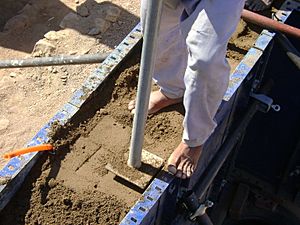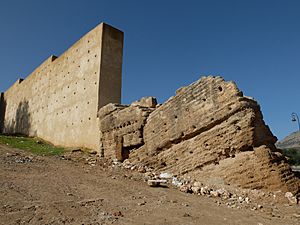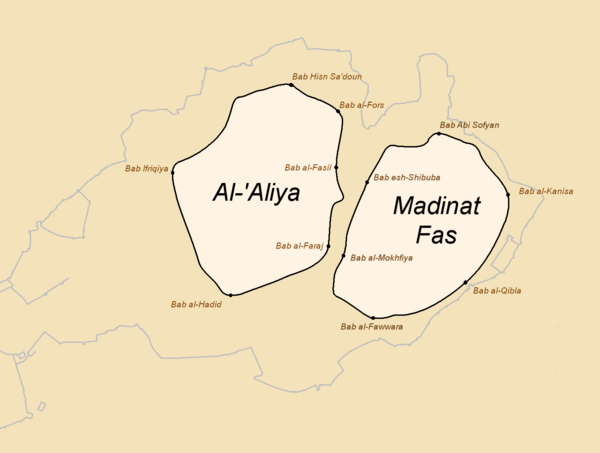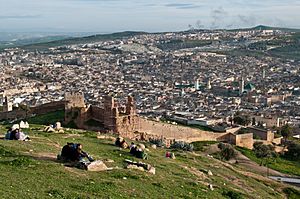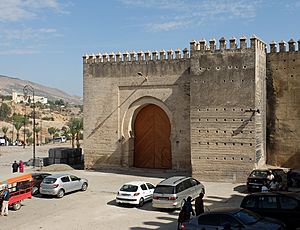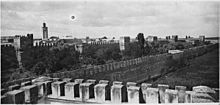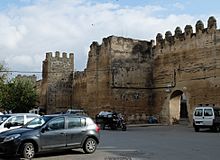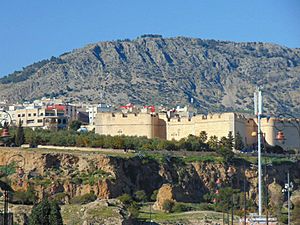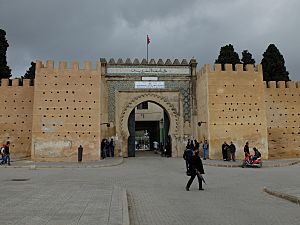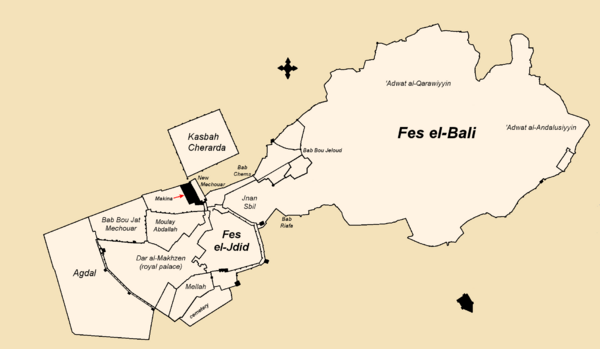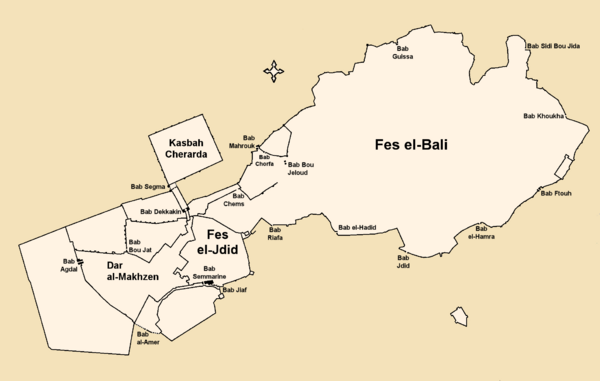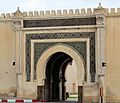Fortifications of Fez facts for kids
The Fortifications of Fez (also called Fes) are a huge network of walls and gates. They surround Fes el-Bali and Fes el-Jdid, which are the old parts of the city of Fes in Morocco. These defenses also include many kasbahs (small forts) and larger forts. They were built over many centuries to protect and control the city. The walls you see today come from different time periods.
The city walls changed a lot over hundreds of years. They were expanded, destroyed, and rebuilt many times. The city gates also look very different, from strong defensive gates to simple openings. These walls showed the city's physical and symbolic limits. The gates often gained special social or political meaning. The city's main cemeteries are just outside the main gates, especially near Bab Ftouh, Bab Mahrouk, and Bab Guissa.
Contents
Why Were the City Walls Important?
Like other old city walls, the walls of Fes had two main jobs: defense and control. They protected the city from attacks and kept strangers out. City gates were usually closed and locked at night. Travelers couldn't enter late.
The walls and gates also controlled who came and went from the city. They could stop people from leaving if the leaders wanted. A very important job was to control goods coming in and out. This made sure taxes were collected properly, since all the important markets (called souqs) were inside the city. Finally, the walls helped define the city's borders. Inside these borders, certain rules and laws applied.
When gunpowder weapons arrived, the old walls became less useful for military defense against big armies. But they weren't rebuilt to stop cannons. This is partly because Fes was inland and rarely faced armies with such weapons. Coastal cities in Morocco, however, often faced threats from Portuguese and Spanish forces. Fes was only taken once by a foreign army, the Ottomans, in 1554. They held it for less than a year before the Moroccan Saadis took it back.
The Saadis later built the only forts in Fes designed to resist gunpowder. Even these forts seemed more about controlling the city, which often rebelled. Local raiders from the countryside rarely had cannons, so the existing walls were good enough against them.
The walls continued to be important for managing the city. The city gates became more about showing off and looking grand. The French colonial government even built the fancy Bab Bou Jeloud gate in the 20th century. This shows how the purpose of the gates changed.
How Were the Walls Built?
The walls of Fes, like those in Marrakesh and other old Moroccan cities, were usually built using a method called rammed earth. This is an ancient building technique found in many parts of the world. It's also known as "pisé" (French) or "tabia" (Arabic).
This method used local materials, making it cheap and efficient. The material was a mix of mud and soil, from smooth clay to rocky soil. Other things like straw or lime were often added to help it stick together. Adding lime also made the walls harder and stronger. (For example, the walls of Fes have a lot more lime than those in Marrakesh or Rabat.) This technique is still used today, though the exact mix of materials has changed.
Workers built the walls from the bottom up, one layer at a time. They pressed and packed the materials into sections held by wooden boards. Once a section was firm, the boards were removed, and the process was repeated on top. This often leaves rows of small holes visible on the walls. Many walls were also covered with lime or stucco to make them smooth and protect the main structure.
These walls needed constant care. The materials let water through easily and can be worn away by rain. Some old structures made with less durable mixes can crumble in just a few decades if left alone. So, old walls stay standing only if they are regularly repaired. Some parts of the walls today look brand new because of this ongoing care, while others are falling apart.
History of the City Walls
Early Fes: Two Separate Cities
Historians aren't completely sure about the exact details of how Fes was founded. But everyone agrees that Idris I started the first settlement, Madinat Fas, on the east side of the Fes River. His son, Idris II, then founded a second settlement, al-'Aliya, on the west side.
These two early cities had their own walls, mosques, and institutions. They were often rivals. Still, this urban center was the capital for the Idrisid dynasty and remained an important city in Morocco.
Almoravid and Almohad Times: Uniting the Cities
In 1069, the Almoravid leader Yusuf ibn Tashfin ordered the walls of both cities to be torn down. Then, a new wall was built around both, joining them for the first time. Even though the Almoravids made Marrakesh their capital, Fes was still very important to them. They built a strong fort (kasbah) on the eastern side of the city.
In 1145, the Almohad leader Abd al-Mu'min attacked and took Fes. Because the people fought back so fiercely, the Almohads destroyed the city's defenses. However, Fes remained important for trade and military reasons. So, the Almohad leader Ya'qub al-Mansur ordered the walls to be rebuilt.
His successor, Muhammad al-Nasir, finished the walls in 1204. This gave Fes el-Bali its final shape and size, which it still has today. Many of the city's main gates were built around this time. Since the city had grown, the new Almohad walls were larger than the earlier Almoravid ones. Like other Moroccan walls, they were built with rammed earth on stone foundations and had rectangular towers. The Almohads also built the Kasbah Bou Jeloud and the first version of the Kasbah an-Nouar. Not all the land inside the walls was built up; much of it was still open with gardens.
Today, the northern parts of Fes el-Bali's walls are believed to be the oldest remaining sections. The strong city gates of Bab Mahrouk and Bab Guissa also still look like they did in the Almohad period.

Marinid Era: Creating Fes el-Jdid
In 1248, the Marinids took Fes from the Almohads. In 1250, the people of Fes rebelled, and the city had to be taken back after a long siege. Because of these rebellions, the Marinid sultan Abu Yusuf Ya'qub decided in 1276 to build a completely new royal city. It was built west of the old city, on higher ground. This new city became known as Fes el-Jdid ("New Fes"). It included the royal palace, government offices, and army headquarters.
Fes el-Jdid had its own strong walls and gates. Its northern entrance, on the road to Meknes, was a fortified bridge. This bridge was between two gates: Bab es-Sebaa (now Bab Dekkakin) and Bab el-Qantara. The southern gate, Bab 'Oyun Sanhaja (later Bab Semmarine), and the western gate, Bab Agdal, all had strong defenses with a bent entrance and towers. Inside, the city was divided into different areas, some with their own walls and gates. A Jewish quarter, the Mellah, was also added.
Most of Fes el-Jdid's outer walls had two layers: a tall inner wall with strong square towers, and a smaller outer wall with smaller towers. Today, a part of these original walls is well-preserved within the royal palace grounds. On the north side, the outer wall extended to include the large Mosara Garden, a royal garden built in 1287. An aqueduct that brought water to this garden was later built into the newer walls of the New Mechouar.
The eastern side of Fes el-Jdid, facing Fes el-Bali, was even more heavily fortified. Both the inner and outer walls were massive, with a military path between them. This extra strength suggests the royal city's defenses were meant to protect the rulers from the people of old Fes, as well as from outside invaders. The Marinids also repaired the walls of Fes el-Bali and built beautiful schools (madrasas) in the old city. This period was a golden age for Fes.
Today, Fes el-Jdid's walls and gates mostly date from the Marinid period. However, some parts have been expanded over the years, especially around the royal palace, which grew many times.
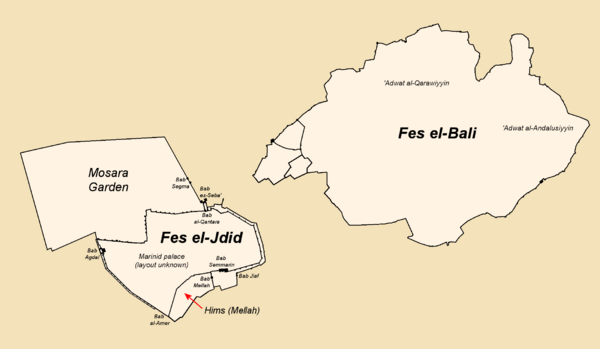
Saadi Era: Taking Control of Fes
After the Marinids and their successors, the Wattasids, declined, Fes went through a difficult time. The Saadi sultan Muhammad ash-Sheikh attacked and took Fes in 1549 after strong resistance. In 1554-55, a Wattasid leader took Fes back, forcing the Saadis to attack and conquer it again.
After retaking the city, the Saadi rulers punished some local leaders and treated the people badly. This made the people of Fes dislike the new dynasty even more. Because of this tension, the Saadis built new forts and strongholds around the city. These were likely meant to control the local population. They were mostly on higher ground overlooking Fes el-Bali, from where they could easily fire cannons into the city.
These forts include the Kasbah Tamdert, inside the city walls near Bab Ftouh. There are also the forts of Borj Nord (North Fort) on the northern hills, Borj Sud (South Fort) on the southern hills, and Borj Sheikh Ahmed in Fes el-Jdid. These were built in the late 16th century, mostly by Sultan Ahmad al-Mansur. Two other strongholds, Borj Twil and Borj Sidi Bou Nafa', were also added to Fes el-Jdid's walls.
Borj Nord, Borj Sud, and the strongholds of Fes el-Jdid are the only forts in Fes that show clear European influence in their design. They were updated to work with gunpowder weapons. Some might have been built with the help of European prisoners from the Saadis' victory over the Portuguese in 1578.
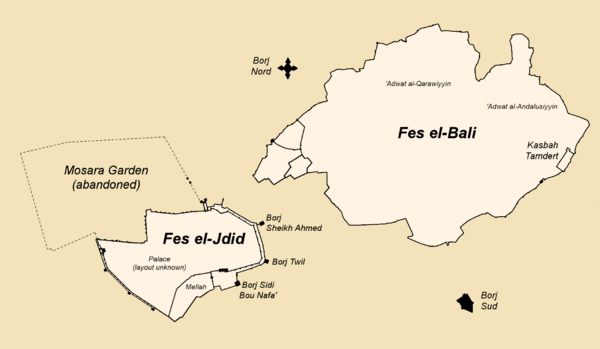
'Alawi Era: Connecting Fes el-Jdid with Fes el-Bali
The founder of the 'Alawi dynasty, Moulay Rashid, took Fes in 1666 and made it his capital. He began to restore the city after a long period of neglect. He built the Kasbah Cherarda (also called Kasbah al-Khemis) north of Fes el-Jdid and the Royal Palace. This was to house many of his tribal soldiers. He also restored the Kasbah an-Nouar, which became home to his followers from the Tafilalt region.
After Moulay Rashid's death, Fes had another difficult time. But from the reign of Moulay Muhammad ibn Abdallah onwards, it became powerful again. The 'Alawis continued to rebuild and restore many buildings. They also expanded the Royal Palace grounds several times.
The biggest change to Fes's layout happened during the reign of Moulay Hasan I (1873-1894). He finally connected Fes el-Jdid and Fes el-Bali by building a walled corridor between them. Inside this new corridor were new gardens and summer palaces for the royals and important people, like the Jnan Sbil Gardens.
The shape of Fes el-Jdid (and the Royal Palace inside it) also changed many times during this period. In the 19th century, the huge Agdal Gardens were created to the west. The Bab Bou Jat Mechouar and the New Mechouar were added to the north. These changes extended the city's boundaries and required moving the Fes River further north.
Forts and Kasbahs
Many forts and walled areas were built across the city over different periods. The word "kasbah" (Arabic: قَـصَـبَـة) means a fortified area. This could be a small fort for soldiers or a larger citadel. Many were named after where the soldiers came from. The word borj (Arabic: برج), meaning "tower," was used for strong military structures, especially those from the Saadi era. Here are some of the most important ones:
- Kasbah Bou Jeloud: This kasbah is not fortified today, but its old shape can still be seen. It includes the Almohad-era Bou Jeloud Mosque. It was once the main fort for the Almoravid and Almohad rulers. It was used as the governor's home until the 20th century.
- Kasbah an-Nouar: Also known as Kasbah Filala. It dates from the Almohad and 'Alawi periods.
- Kasbah Cherarda: Also known as Kasbah al-Khemis. It dates from the 'Alawi period.
- Kasbah Tamdert: Near the Bab Ftouh gate in the southeast. It dates from the Saadi period.
- Borj Nord: This Saadi fort shows the clearest signs of European design. It stands on the hills north of the city, near the Marinid Tombs. Today, it is an Arms Museum.
- Borj Sud: The "sister" fort of Borj Nord. It stands on the hills overlooking Fes el-Bali from the south.
- Strongholds of Fes el-Jdid: These three huge towers were built by the Saadis on the eastern and southeastern corners of Fes el-Jdid's walls.
- Borj Sheikh Ahmed: The northernmost and easternmost stronghold. It was built at the corner of the walls closest to Fes el-Bali. Today, you can see it overlooking the southern edge of the Jnan Sbil Gardens.
- Borj Twil: The southeastern stronghold, located between the other two.
- Borj Sidi Bou Nafa': The southernmost stronghold. It is on the south side of what used to be the Bab Jiaf gate (now a main road).
City Gates
There are many gates in both Fes el-Bali and Fes el-Jdid. They vary in importance, from large military structures to simple openings. Here is a list:
Gates of Fes el-Bali
- Bab Mahrouk: This was historically the main western entrance to the city. It was built in the early 13th century during Almohad rule. The Bab Mahrouk Cemetery and Kasbah an-Nouar are nearby. Its name means "Gate of the Burnt."
- Bab Bou Jeloud: This is the main western entrance to Fes el-Bali today. It is a famous landmark of the medina. It was built in 1913 at the start of French colonial rule, replacing an older, simpler gate.
- Bab Ftouh: The main southeastern gate of Fes el-Bali. Its current form dates from the Almohad period (12th-13th century). The Bab Ftouh Cemetery and Kasbah Tamdert are nearby.
- Bab Guissa: The main northeastern gate of Fes el-Bali. Its current form also dates from the Almohad period. The original gate has a bent entrance, but a smaller side gate was later opened for easier access. The Bab Guissa Mosque is next to it.
- Bab el-Hadid: This gate is in the southwestern part of the city walls. Historically, this area was not densely built up and had mostly gardens and mansions. So, no major roads led to it for most of its history.
- Bab Jdid: Meaning the "New Gate." This gate was at the southern end of the city, near where the central river (Oued Bou Khrareb) exits. Like Bab el-Hadid, it wasn't a major gate historically. Today, a main road for cars and buses passes through this area, leading to Place R'Cif.
- Bab Sidi Bou Jida (or Bab Sidi Boujda): A small gate today, located at the northeastern tip of the city. It was the outer entrance to the Keddane district. Earlier gates in this area were called Bab Abi Sofyan and Bab Beni Msafer.
- Bab el-Hamra: Meaning the "Red Gate." This gate was west of Bab Ftouh, but it seems to have disappeared by the 16th century. Its name lives on in the Bab al-Hamra Cemetery.
- Bab Khoukha: Also known as Bab Knisa ("Gate of the Church"). It was at the eastern/southeastern end of the city, northeast of Bab Ftouh. Like Bab al-Hamra, it had disappeared by the 16th century, leaving only its name in the area.
- Bab Chorfa: The gate to the Kasbah An-Nouar, a fort at the western end of Fes el-Bali. Its current look is from the 'Alawi era. The name means the "Gate of the Sharifs."
- Bab Chems: This simple gateway is at the western end of Place Bou Jeloud. It was probably opened in the late 19th century when Moulay Hasan I built the corridor connecting the two cities. "Bab Chems" means "Gate of the Sun" in Arabic. It was originally built in an Italian style and called Bab Campini. French officials later changed it to its current traditional Moroccan look.
Gates of Fes el-Jdid
- Bab Semmarine: This gate is near the Jewish Quarter (Mellah), at the southern end of Fes el-Jdid's main street. Built in 1276, it was the main southern gate of the city's inner wall. It was changed in the early 20th century.
- Bab al-Amer: This gate also dates from 1276. It is the main western entrance to Fes el-Jdid, near the western end of the Jewish Mellah. It was on the outer southern wall of Fes el-Jdid.
- Bab Dekkakin (or Bab Dekakene): Located between the Old Mechouar and the New Mechouar, directly across from the royal palace entrance. The name means "Gate of the Benches." It was originally called Bab es-Sebaa ("Gate of the Lion"). It dates from 1276 and was the main northern entrance to Fes el-Jdid. It was modified in the late 19th and early 20th centuries.
- Bab Segma: This gate is between Kasbah Cherarda and the New Mechouar walls. It has two huge octagonal towers from the Marinid period. These towers were part of an entrance to the Mosara Garden, a large Marinid royal garden from 1287. The gardens disappeared after the Marinid period, leaving only the towers. The name comes from a woman named Amina Sagma who was buried there.
- Bab Kbibat es-Smen: This is the northern entrance gate to the New Mechouar. It dates from 1886, when Moulay Hassan built the nearby Dar al-Makina. It is sometimes also called Bab Moussiki.
- Bab Bou Jat: The former western entrance to the Moulday Abdallah quarter of Fes el-Jdid. It was closed off when the royal palace grounds expanded.
- Bab Agdal: A well-preserved Marinid-era gate, probably from 1276. It is at the northwestern corner of the Lalla Mina Gardens inside the Royal Palace. This gate, with its bent entrance, was once the western entrance to Fes el-Jdid. It became less important when the large Agdal Gardens were created to its west.
- Bab Jiaf (or Bab Sidi Bou Nafa'): This gate no longer stands today. It was on the outer southern wall of Fes el-Jdid, east of Bab Semmarine. The area is now crossed by a main road. Its name still exists in the area, and a nearby Saadi stronghold was named after it.
- Bab Riafa (or Bab Jbala): This gate is in the southern wall of the corridor built by Moulay Hassan in the 19th century to link Fes el-Jdid with Fes el-Bali. It was once a military post for troops from the Rif mountains. So, its name means "Gate of the Rifians" (Bab Jbala means "Gate of the Mountain"). A main road passes through a modern gateway here today.
- Bab el-Mellah: This gate is inside the southernmost district of Fes el-Jdid, along its main street. It marked the boundary between the Sidi Bou Nafa neighborhood and the Jewish Mellah. The original gate had a bent entrance and two large defensive towers.
See also
 In Spanish: Fortificaciones de Fez para niños
In Spanish: Fortificaciones de Fez para niños
- Walls of Marrakesh
- Architecture of Fez



